 Facebook
Facebook
 X
X
 Instagram
Instagram
 TikTok
TikTok
 Youtube
Youtube


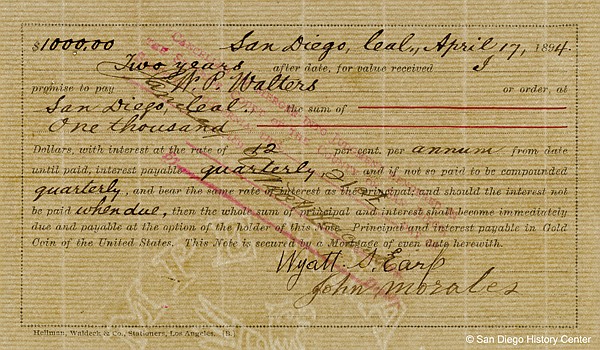
1. Wyatt Earp Promissory Note
Most San Diegans who recognize the name know that the onetime deputy sheriff of Tombstone, Arizona, was also a notorious carpetbagger. Earp and his pal, Doc Holliday, killed — some say murdered — three cowboys during the gunfight at the O.K. Corral. Eventually, Earp, with various clans gunning for him, left Arizona and followed Horace Greeley’s advice: “Go West, young man.” His love of gambling brought him to San Diego in 1885. With the hand-rubbing promise of the railroad (which never came), he wagered his and others’ money during the real-estate boom. He controlled four saloons and gambling halls, two near Sixth and E Street, and one, the Oyster Bar, in the Louis Bank building on Fifth Avenue. (The district, once the Stingaree, is today’s beer-and-burger haven, the Gaslamp.) On a very good night, Earp raked in as much as $1000. Flush, he spent it on prizefighters and racehorses, games in which, citing Raymond Starr’s phrase, the greedy Earp “sought to divest other speculators of their profits.” But the law caught up with him. This note, in the research library of the San Diego History Museum, is for $1000, payable to W. P. Walters, and it is signed by Earp and John Morales, an accomplice, no doubt; it is dated 1894. By then, the lawman was an outlaw, having ventured as far as Alaska, though Walters’s suit forced him to return and pay up. Progress, indeed, since it was a court, not a corral, settlement.
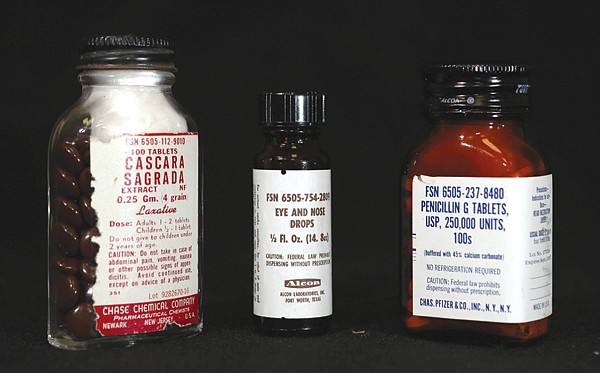
2. Bomb Shelter Pills
Even in paradise, the Cold War occasioned the stashing of survival kits in many a San Diego basement, in homes, businesses, and schools. These three vials were located in supply barrels stacked in the San Diego State College administration building cellar, placed there in January 1964. We tend to date our showdown with the commies to the 1950s, but the fallout-shelter craze occurred from 1962 to 1970. Each person was provisioned for two weeks — the optimal time officials believed it took for nuclear fallout to clear. (An astoundingly dumb notion, considering denizens of Hiroshima were still dying, two decades on.) Shelter kits had food (1600 biscuits in 18-pound tins), water (in 17½-gallon drums), sanitation supplies, a radiation-detection kit, a medical pack, and pamphlets on caring for those poisoned by atomic dust. Among the medicines were eye and nose drops, penicillin tablets, and an extract called cascara sagrada or “sacred bark,” a natural laxative. (For those scared s---less.) In America, some 200,000 home shelters were erected while millions of subterranean hideouts were equipped courtesy of the Office of Civil Defense. When the siren sounded, one ran to the nearest sign, often nailed around public schools — three inverted yellow triangles encircled in black.
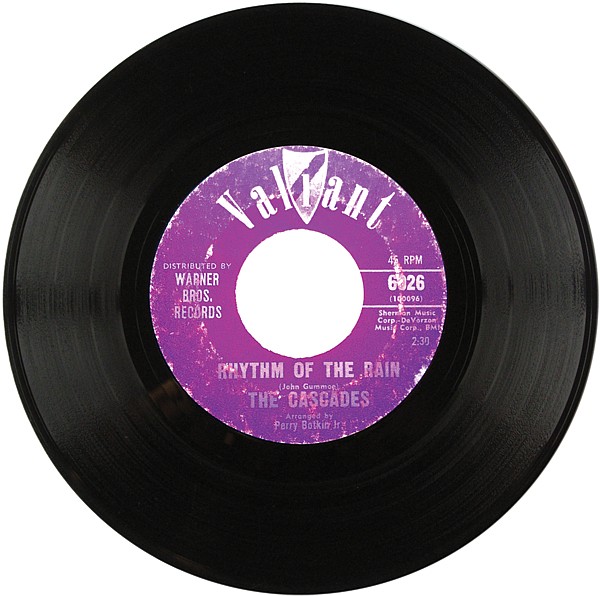
3. “Rhythm of the Rain,” the Cascades
In the halcyon months before JFK died, four skinny kids from San Diego recorded the city’s greatest original pop tune. A timeless 2´30˝. The vinyl 45. The juke box. The home turntable and its mechanical arm dropping onto the turning groove. The same 2:30 playing over and over and over on every car radio during March 1963, when it climbed to number two on national charts, barred from the top by “Walk Like a Man” by Frankie Valli and the Four Seasons. With a few sailors from the USS Jason, John Gummoe formed the Cascades. He wrote the song during a thunderstorm, while on duty in the Aleutian islands. In November 1962, the group cut the single, a million-seller bought by tens of thousands of San Diego kids, at Phil Spector’s Gold Star Studio in Hollywood, using an echo chamber to layer voices, instruments, and drums. Gummoe’s solo voice combined with the Everly Brothers’–style harmony (ahhhh, gone away; pitter pat, pat-pat-pat), the rinky-ding-ding melody on glockenspiel, and that peerless opening — thunder crash, falling rain, tune rolling in, one of the sweetest blends ever of lyric and sound effect to texturize a pop tune.
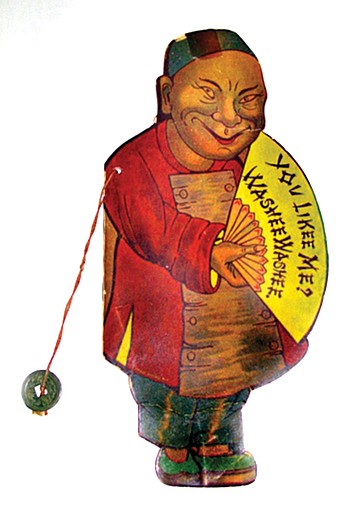
4. Chinese Laundry Ticket Pad
One hundred years ago, the local Chinese population got its foothold via hand laundries. Before that, the Chinese Exclusion Act of 1882 limited the numbers the U.S. allowed in, a response to the fear that foreigners would take jobs from natives. Ticket-printers marketed this fear to the laundries themselves, which were located in Chinatown, near to Earp’s gambling dens. Under glass at the Chinese Historical Museum, the pad’s cover rings with the stereotype of the Chinaman: sinister grin, pointy fingernails, (probably) high on opium. In the bamboo lettering, you can almost hear the jeering English rhyme. The man’s queue, or pigtail (which runs down his back), was a symbol of oppression in China; in America, it meant pride in one’s heritage and a kind of allegiance to their adopted home. Growing one’s queue long and braiding it showed your group that you weren’t going back to China. Why a laundry? A small business was a way to be one’s own boss, to open a shop with very little money and do what many, especially port-calling sailors (the main clientele), considered beneath them — washing clothes.
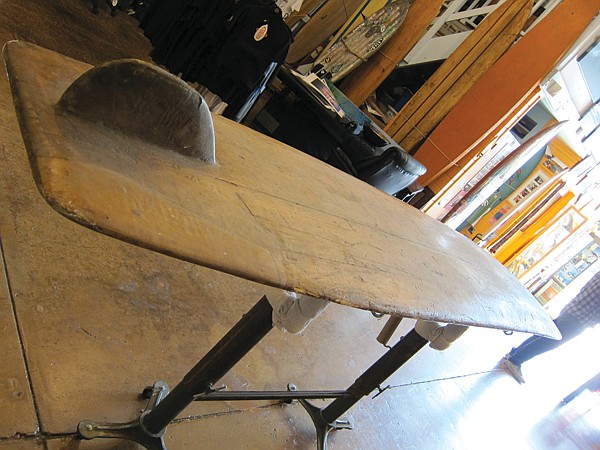
5. Bob Simmons Surfboard
Once, surfboards were made from redwood planks and weighed 75 pounds. But surfer Bob Simmons, an ungainly kid from L.A. who beat cancer with a plant-based diet and lived out of his 1937 Ford Tudor sedan, changed that. During the war, he was a machinist, then studied hydrodynamics at San Diego State. A loner, Simmons loved to mull a board’s lift, drag, shape, and weight. As a shaper, he garage-worked boards, using the new Styrofoam or other materials from the war. Late 1940s, he sculpted a 25-pound balsa board with a fiberglass seal that shimmered like corn syrup. Its rounded bottom, contoured rails, spoonlike nose, wide-and-thin squared-off tail, and skeg, or rudder, made the plank wave-face fast. Simmons rode his last wave in 1954, when he was struck in the head by his board at Windansea beach; a lifeguard buddy found his body days later. (A fellow surfer rode this board — which can be seen at Bird’s Surf Shed — near Windansea the same day Simmons died.) Nowadays, a Bob Simmons (he made about 100) commands $25,000 at auction. An 11-footer recently went to a Hawaiian collector for $40,000. A Skip Frye board, with its foiled fins, is a descendant of Simmons’s innovations, heir to the master’s graceful, curvy contours.

6. “El Jupiter,” Presidio Cannon
Cast in the Philippines in 1783, this big bronze gun saw its first action at the Spanish outpost Fort Guijarros on Point Loma. Part of a ten-gun battery, the cannon fired 25-pound shots on smugglers during 1830’s “Battle of San Diego Bay.” In 1837, the weapon — its six-foot barrel weighed two tons — was wagoned to the Royal Presidio, a military bulwark protecting Father Junípero Serra’s first mission. Ever wary, the padres soon moved the mission six miles east. The Presidio, having fallen into Mexican hands, was abandoned, though the cannon continued to glower at modest farms in Mission Valley at the mouth of the San Diego River. The gun remained in place during the U.S.-Mexican war, 1846–1848, when the United States acquired a western land mass whose biggest prize, Alta California, became our state in 1850. Geranium-lover George Marston, who owned the Presidio and its grounds and gave it to the city in 1929 (imagine someone doing that today), kept the cannon in the basement of his downtown store. Today, it’s housed in the Serra museum. The Presidio is an archaeologist’s dream, as many a trowel has exposed artifacts from the Kumeyaay, Spanish, and Mexican eras.
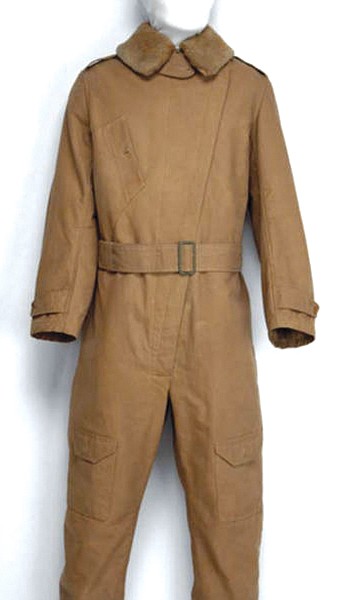
7. Charles Lindbergh’s Flight Suit
When Lucky Lindy took off from San Diego on May 10, 1927, in his wicker-seat, single-prop monoplane, he was snug in this A.G. Spalding & Bros. fur-collared, brown cotton twill coverall. Price, $50. After 34 hours in the air, he landed in Paris and wrote inside the suit’s collar, “Worn on the following flights: San Diego–St. Louis, St. Louis–New York, New York–Paris. Charles Lindbergh.” (The suit is on display at the Missouri History Museum in St. Louis.) The pilot, as every school kid knows, flew Spirit of St. Louis, designed and built in 60 days by Ryan Airlines Corporation. He oversaw the plane’s construction in a vacant cannery building on the site where Solar Turbines is today. Engineers reduced the weight wherever possible: no parachute, no radio, no lights, no windshield. The gas tank was in front of him, so he steered by looking out the window. Why wasn’t it the Spirit of San Diego? The financial backers — who provided $15,000 to build the plane, hoping Lindbergh would win the trans-Atlantic prize — were St. Louisians. The aviation expertise (president Frank Mahoney, chief engineer Donald Hall, a few dozen workers, and lots of overtime) was all San Diego’s.
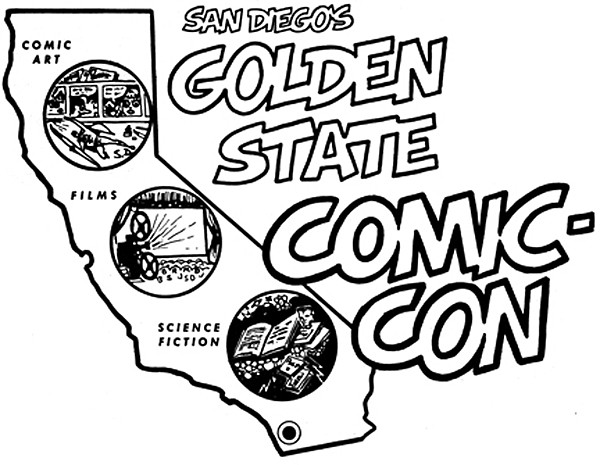
8. First Comic-Con Logo, 1970
Our glitziest summertime blowout is the San Diego Comic-Con International. Its initial offering was held in 1970 at the US Grant Hotel; 300 attended. O’er the swamp of recent time, the event has mushroomed from a coterie of comic-book and fantasy/sci-fi novel enthusiasts to its present-day circus of geekdom and fandom: superheroes (the fake real, like Captain America, and the real fakes, like Arnold Schwarzenegger), the newest movie-blockbuster and marquee stars, the Cartoon Network, anime, video games, workshops and panels, a costume contest, portfolio review, an art show, an awards ceremony, collectors and collectibles, trash bags full of free merch, and old bald surfer dudes in Tommy Bahama shirts. Tickets sell out in the first hour and a half they’re offered. The four-day party reportedly generates $162 million in tourist revenue. Capped now at 125,000 attendees, Comic-Con attracts T-shirted, swag-cut throngs who sardine themselves in the convention center, the one event that Big House by the Bay seems built for. Like the Alien series, the affair rebirths itself, every year more corporatized and commercialized, a showcase for a fantasy realm where it’s the sponsors’ goal that no one grows up.

9. Burned Tennis Shoes, Cedar Fire
Not that San Diegans need reminding, but the Cedar Fire was one of the worst catastrophes in the region’s history. It burned 280,278 acres (roughly 28 percent of the county), 2232 homes were lost, and 14 civilians and one firefighter died. This pair of tennis shoes is kept in the 60-degree storage vault of the Barona Cultural Center. Igniting spontaneously from the heat, the shoes sat on the back porch of Charles “Beaver” Curo, onetime vice-chairman of the Barona band, whose house was spared that night, October 25, 2003. At its fiercest moment, the fire roared down Wildcat Canyon at 40 miles per hour. The terror for many victims was unthinkable. Three people perished in their bathtubs, where they huddled, trying to outlast the heat and smoke and flames. Hundreds of survivors have scars, grafted skin, lost fingers, ghastly dreams.
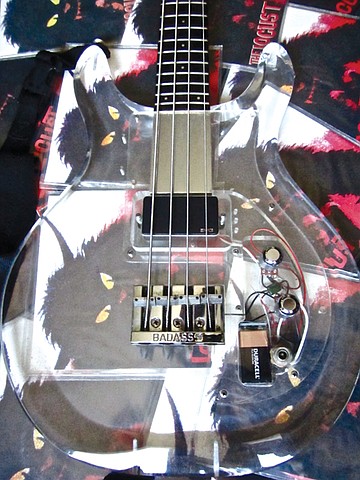
10. Justin Pearson’s Acrylic Bass
San Diego has fostered very few West Coast musical styles. Except one. Punk. Today, it’s variously known as noise rock, screamo, grindcore — bizarre-timed clusters of explosive sounds and blast beats at supersonic speed. But for two decades, punk was largely pure, and one reason is its local crown prince, Justin Pearson. Pearson has played his transparent acrylic bass, built by Dan Armstrong, with the Locust. How to describe their music? IED rhythms. Growled/shrieked lyrics. A virtuosic noise, touched by riotous energy. I recall one Locust tune of 54 seconds and 7000 notes, the playing high-voltage, incandescent. The Locust don matching human-fly costumes with hoods and mesh sockets for eyes and mouth. Few local punk groups hit it big (some say sold out): Unwritten Law, blink-182, Rocket From the Crypt, Black Heart Procession. But the litany of wild-at-heart bands that played all-ages shows — at such venues as the Ché Café, WorldBeat Center, Soma — are legendary: the Cramps, Nomeansno, Head Wound City, Cattle Decapitation, Pitchfork, Tit Wrench. Half the fun was pissing off the parents. Lest we forget, there’s a public service to punk — the audience, mostly teenage men and boys, enjoys its club sport: mosh-pit slam-bang sweat-frenzy workout. Punk cultures rebellion, and seeds a participatory politics for San Diego’s many alienated kids.
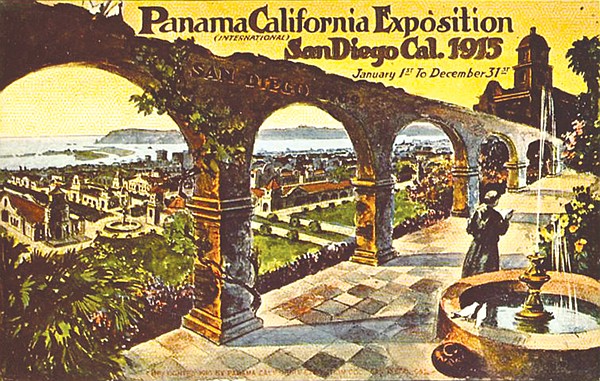
11. Panama-California Exposition
Held from 1915 to 1917, the exposition presented our city as the initial stop after ship passengers traversed the just-finished Panama Canal. Expositions and fairs used to peddle a city’s newness, all set to grow, by imagining its identity. For San Diego, a few of these events decided that its architectural face would be Spanish Colonial Revival. The consequence launched an ongoing crisis: Was there a here, here? The answer: it’s not necessary. According to our town barkers, Southern California should evoke elsewhere. How strange to think it couldn’t be itself: a U.S.-Mexican crossroads; a marine Eden; abundant, adaptable land, wisely occupied by native peoples for 8000 years. Instead, the park grounds beckoned tourists with what expo builder Bertram Goodhue called “illusion rather than reality.” This postcard frames the theme: the viaduct is a Roman ruin; the city behind and below mixes Florence and Los Angeles; the bay invites shipping; and the scurrying Bible-toting friar — well, he’s no lover of baseball but a force christening canyons and caminos a Catholic colony. That San Diego has been challenging its putative expo identity for nearly 100 years has become its identity. One good thing: the 1915 structures anchor the best stroll in town: Balboa Park.

12. Squid Tuna Hook
This squid — a tuna lure — is the size of a man’s hand, made of brass and filled with lead. Its rooster feathers are string-cinched over animal skin: wet feathers, jumping on the ocean surface, resemble a squid, a bait tuna can’t refuse. It’s known as a three-pole squid: attached to three poles and wielded by three men, one of these hooks landed a 150-pound tuna. (Squids are on display at the Maritime Museum of San Diego.) From the 1930s to 1980s, San Diego was the tuna capital of the world. Catching and canning the Pacific bluefin and the albacore was the third largest driver of the city’s economy, behind the Navy and the aircraft industry. Before 1930, the Japanese in San Diego dominated the trade; after that, immigrant fishermen streamed in from Portugal and Italy and took over. Canneries at the Tenth Avenue terminal, such as Van Camp, Starkist, and Bumble Bee, employed thousands. Day and night, a whistle blew when loaded boats docked and gutters and cookers hustled to work. Small crews on bait boats motored south to the tropics, as far as the Galapagos Islands, for weeks or months. One by one, they caught the fish, slid them into the hold, and covered them with ice. A typical load was 100 tons. After well-enforced laws to protect the porpoise, a fellow-traveling mammal that got caught in the nets, the tuna industry went belly up.

13. National League Championship, Game 4 Ticket
Most (middle-aged/older) San Diegans remember where they were when they saw this game, October 6, 1984 — a few at the Murph, hundreds of thousands in front of their TVs. Michael Babida, who works for the Padres today, knows where he was: he saved his ticket. It was the greatest moment in our sports teams’ history, brought to us, vexingly, by an ex–Los Angeles Dodger, Steve Garvey, nicknamed “Mr. Clean.” In the best-of-five series, the Padres were down, two games to one, to the Chicago Cubs. The fourth game was tied 3-3 when the Friars scratched ahead in the bottom of the seventh inning, 5-3, only to be knotted up again by the Cubs in the next inning, 5-5. In the bottom of the ninth, after Tony Gwynn hit a single, Garvey, who arrived from the Dodgers in 1983 — $6 million over five years — took a ball. But not the next pitch. Boom! he connected, and the announcer called it: “Deep right field. Way back. Cato [the right-fielder] going back. To the wall. It’s gone. Home run, Garvey — and there will be tomorrow.” Like an Olympic athlete in protest, Garvey pumped his white-gloved fist in the air. The clutch hitter had five RBIs for the day, culminating in his walk-off home run. Everyone knew the gods would smile on the Pads again; coming from behind, they won the fifth game and earned the National League pennant.
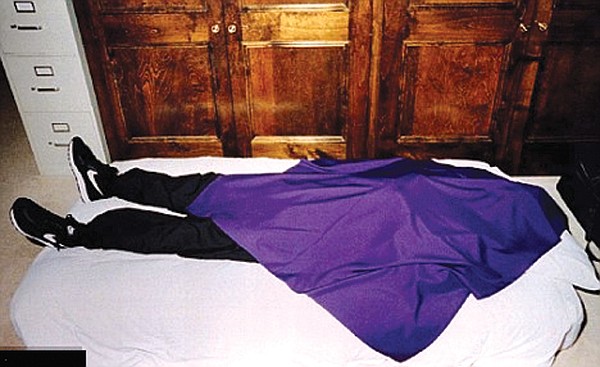
14. Heaven’s Gate Purple Shroud
One day in March 1997, Heaven’s Gate’s 39 men and women put on new Nike hi-tops, identical black shirts, and sweat pants, ate Phenobarbital-laced apple sauce and pudding, chased with vodka, and lay down to await a painless death. In their Rancho Santa Fe mansion, they suicided in shifts. Each corpse was draped with a square purple shroud (one is on display at Hollywood’s Museum of Death), probably by their leader, Marshall Applewhite, the last to go. When found three days later by an ex-member and videotaped, a frenzied media revealed the uniformity of the horror. Each had made an “Exit Video.” They described their bodies as “vehicles,” their time on Earth spent “growing a soul.” (Strict cult rules meant behavioral conformity, high-tech jobs, no sex: over-testosteroned men were voluntarily castrated.) The planet was about to be “recycled,” so they “evacuated” en masse for the “Next Level.” Their “out” came as a comet, a 25-mile-wide chunk of ice called Hale-Bopp, passing near enough our solar system to catch. Attached to Hale-Bopp, in its 20 million-mile tail of gas, was, they thought, a spaceship (the Gate) they would board. In their videos, each member offers in the bougainvillea-bordered backyard, on a gloriously bright spring day, his or her unsentimental farewell. In the next life, each would be reborn as “nonhuman.” They would not die but return to space, where they belonged. Heaven, if you will.
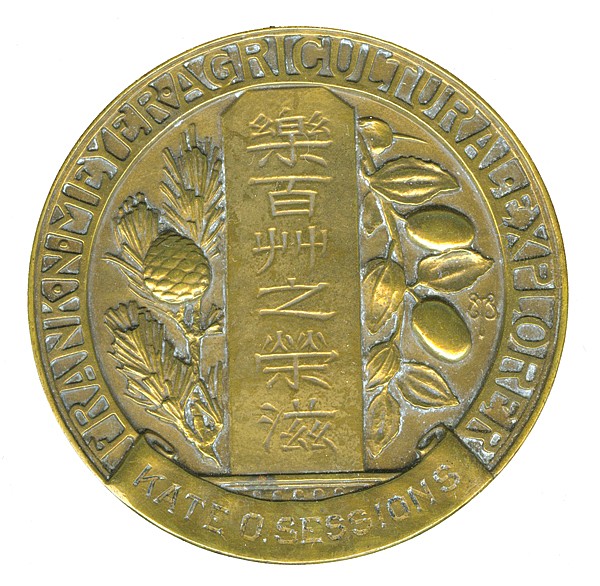
15. Meyer Medal for Kate Sessions
In 1939, the American Genetic Association presented its Frank N. Meyer medal, today in the collection of the San Diego History Museum, to the 82-year-old Sessions, the “Mother of Balboa Park,” citing her long career of introducing foreign plants to the region. By turns a schoolteacher, nursery-owner, flower-shop proprietress, horticulturalist, landscape architect, and seed collector, Sessions was a force in local botany and gardening for 55 years, until her death in 1940. Under a land-lease agreement for her commercial nursery, every year she planted 100 trees in Balboa Park and 300 throughout the city. Here’s a short list of her green-thumbed propagations: agave, aloe, fig, cypress, pine, oak, pepper tree, eucalyptus, ceanothus, jacaranda, bird of paradise, poinsettia, one mighty still-standing Tipuana tree at the corner of Garnet and Pico in Pacific Beach, and the mesembryanthemum, or iceplant. If you loll in the park’s palm grove — she grew those Brahea brandegeei from seeds gathered in Baja California — thank Kate’s trusty spade and loving touch for the magnificent flora beside and above you.
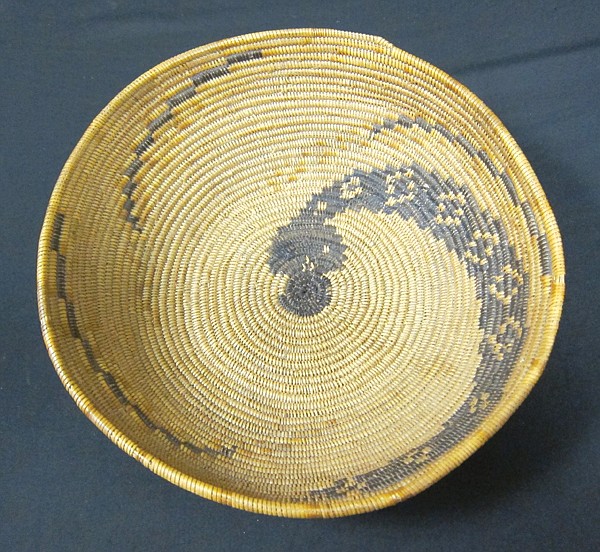
16. Kumeyaay Rattlesnake Basket
Dating from the 1870s, this basket, from the Barona Cultural Center, belonged to the grandmother of Josephine "Sister" Romero, a descendant of the Capitan Grande Indians, who were split into the Barona and Viejas bands. (Kumeyaay is a language group, spoken by and identifying the ’Iipay/Diegueño people.) One theory of the basket’s design is that the white diamondback snake woven into the bottom — an animation prototype; motion lines indicate its slithering descent — would scare off squirrels, rabbits, and other small game from filching. The bundle coil is made of juncus, a riverine rush or plant stem; the elongated rods, darkened and almost pixel-shaped, are dyed. Alas, rattlesnake talismans didn’t stop the human filching. In 1930, the Capitan Grande Indians were ordered to leave one part of their homeland to greenlight the county’s El Capitan dam and reservoir. Pooling buyout money, some members bought land and relocated themselves in the Barona Valley. Not every removal ends badly. Today, the Barona Band is thriving with a mission, a golf course, a casino, and a 400-room hotel.
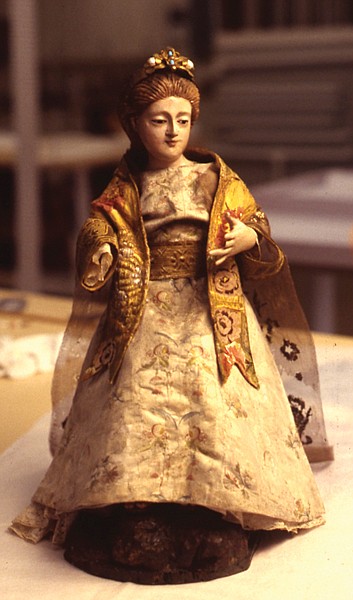
17. Rancho Guajome Santo
In the Mexican land-grant era, Rancho Guajome was a 2200-acre parcel given to two Luiseño Indian brothers. They sold the property and hacienda to an L.A. investor who gave it, a wedding present, to his sister-in-law, Ysidora Bandini. Her family resided at the site of the Casa de Bandini restaurant, formerly in Old Town. Rancho Guajome, with its 20-room adobe, flourished during the cattle boom. In its heyday, it consisted of a dusty spread of beef and leather production, a ranch store and tack room, and annual fiestas and rodeos. (Author Helen Hunt Jackson did research for her romance Ramona at the ranch.) Likely kept in Ysidora’s private chapel (permission to build granted by the Pope himself) was this 18th-century Santo, an unknown female saint, made of painted wood; her identity is unknown. Beneath her silk dress with cuffed sleeves is a chemise, an underskirt, and a petticoat; a sash, mantle, and shawl complete the ensemble. With her pierced ears and wax pearls in her hair ornament, she seems an everyday type, closer to a ranch socialite than a holy woman. Doña Ysidora raised ten children at Guajome with her husband, Cave Johnson Couts. One of the luckier post-statehood entrepreneurs — his holdings grew to 20,000 acres — Couts couldn’t stop an economic downturn and a punishing drought in the 1860s. Ysidora, no doubt, prayed for better times while adorning her Santo.
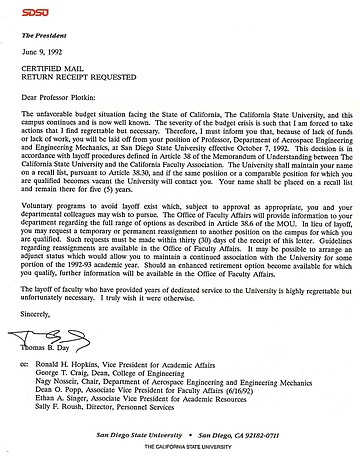
18. SDSU President Thomas Day’s Pink Slip
Let the battle to end lifelong state employment begin, SDSU president Thomas Day said to the college in June 1992. The shrewd but ham-handed leader sent 111 termination letters to the faculty, cutting nine departments and 662 class sections, and canceling the majors of 1000 students. His surgery was in response to a legislature-mandated 8 percent drop in the state education budget, on top of the previous year’s 15-percent plunge. The ouster included anthropology, German and Russian, and religious studies, as well as recreation, parks, and tourism (who knew that was a major), plus this letter’s addressee, Professor Allen Plotkin, his tenured job and his department, Aerospace Engineering and Engineering Mechanics. (The letter is in the collection of SDSU’s anthropology department.) The affair turned nasty three months later when lawsuits were filed, SDSU students protested, and a “Wanted” poster was issued with a snarly photo of Day and the caption, “Threat To Academic Freedom.” Chastened, he postponed the cuts. Within months, he rescinded the order. How should Day have handled it? His detractors said a humane boss would have rerouted money from infrastructure, travel, and library books. For four more years, Day embroiled faculty by denying new hires until his retirement. His legacy? SDSU became “the university that tried to kill tenure.”
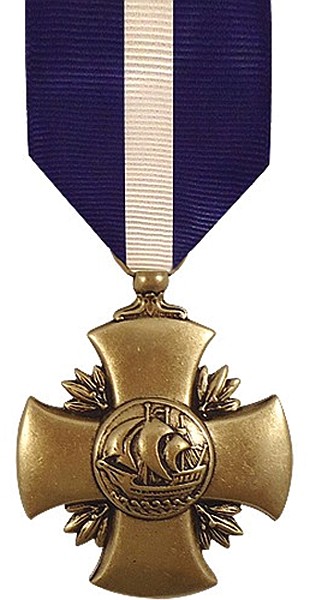
19. Navy Cross
The greatest firefight of the Iraq War was the First Battle of Fallujah. Prompted by the execution, bridge-hanging, and videotaping of four Blackwater contractors in April 2004, the 1st Marine Expeditionary Force tried but failed to take the city from insurgents. A second assault came in November, spearheaded by the 1st Battalion, 3rd Marine Regiment, whose scout leader was Sgt. Rafael Peralta. The 25-year-old San Diegan led his squad in house-to-house combat. Wounded in the back of the head by friendly fire, he was shot by the enemy in the chest and fell. A grenade landed next to him. He pulled it underneath his body, his death saving six Marines. Peralta’s regiment nominated him for the Medal of Honor, America’s highest military award. The Marine Corps, U.S. Central Command, and the secretary of the Navy agreed. But defense secretary Robert Gates and a review panel voted no, arguing that he probably smothered the grenade “unconsciously.” (The Medal of Honor, given to 3459 soldiers, requires acts of valor “without any possibility of error or doubt.”) The brass gave him the Navy Cross, the second-highest award. His family turned it down. Eight years later, the decision is caving under a storm of protest. Based on new evidence, Gates’s ruling is under review. An act of Congress can overturn it. Meanwhile, the Navy has said it will name a destroyer after Peralta.
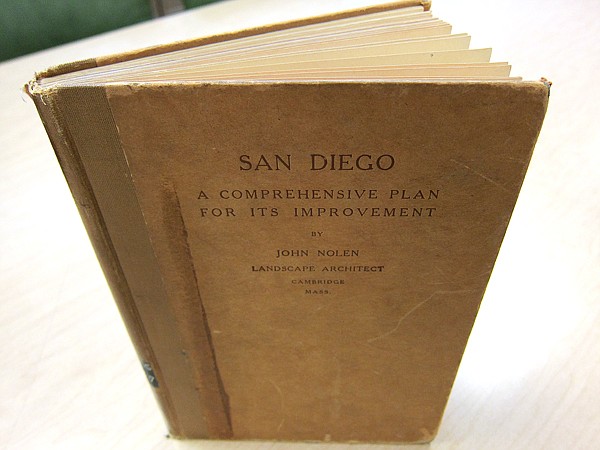
20. San Diego: A Comprehensive Plan
In 1908, George Marston hired Boston architect John Nolen to make a plan for San Diego’s growth, one that would join people to the environment. In dignified prose, Nolen lingers on the potential for a “city beautiful.” Its “location and physical foundation” may yet make it “great”; the bay is “one of the safest and most beautiful harbors in the world”; its climate “defies description,” in part, because without “extremes of heat or cold…health is almost guaranteed”; and its backcountry “is an inexhaustible source of commercial and aesthetic wealth.” Neither Marston nor Nolen opposed development. But without planning, from 1908 forward, the master designer felt the place was doomed. Thus came the bad news. San Diego is “neither interesting nor beautiful”; it “has no wide and impressive business streets, practically no open spaces…no worthy sculpture”; and “it has no pleasure grounds, parkways nor boulevards, no large, well-arranged playgrounds.” The only hope was to balance aesthetics and opportunity, curtail the developers’ hodgepodge, rubber-stamped by a building-friendly city council. Nolen’s 1908 vision was rejected, but his 1921 plan was passed. From it we got a city center, an airport on the harbor, and a sleek expressway through what was then the unspoiled Mission Valley. Drive today, though, on the 805 above that valley and behold the mushroom condos colonizing the expanse like War of the Worlds. Who the hell planned that?




1. Wyatt Earp Promissory Note
Most San Diegans who recognize the name know that the onetime deputy sheriff of Tombstone, Arizona, was also a notorious carpetbagger. Earp and his pal, Doc Holliday, killed — some say murdered — three cowboys during the gunfight at the O.K. Corral. Eventually, Earp, with various clans gunning for him, left Arizona and followed Horace Greeley’s advice: “Go West, young man.” His love of gambling brought him to San Diego in 1885. With the hand-rubbing promise of the railroad (which never came), he wagered his and others’ money during the real-estate boom. He controlled four saloons and gambling halls, two near Sixth and E Street, and one, the Oyster Bar, in the Louis Bank building on Fifth Avenue. (The district, once the Stingaree, is today’s beer-and-burger haven, the Gaslamp.) On a very good night, Earp raked in as much as $1000. Flush, he spent it on prizefighters and racehorses, games in which, citing Raymond Starr’s phrase, the greedy Earp “sought to divest other speculators of their profits.” But the law caught up with him. This note, in the research library of the San Diego History Museum, is for $1000, payable to W. P. Walters, and it is signed by Earp and John Morales, an accomplice, no doubt; it is dated 1894. By then, the lawman was an outlaw, having ventured as far as Alaska, though Walters’s suit forced him to return and pay up. Progress, indeed, since it was a court, not a corral, settlement.

2. Bomb Shelter Pills
Even in paradise, the Cold War occasioned the stashing of survival kits in many a San Diego basement, in homes, businesses, and schools. These three vials were located in supply barrels stacked in the San Diego State College administration building cellar, placed there in January 1964. We tend to date our showdown with the commies to the 1950s, but the fallout-shelter craze occurred from 1962 to 1970. Each person was provisioned for two weeks — the optimal time officials believed it took for nuclear fallout to clear. (An astoundingly dumb notion, considering denizens of Hiroshima were still dying, two decades on.) Shelter kits had food (1600 biscuits in 18-pound tins), water (in 17½-gallon drums), sanitation supplies, a radiation-detection kit, a medical pack, and pamphlets on caring for those poisoned by atomic dust. Among the medicines were eye and nose drops, penicillin tablets, and an extract called cascara sagrada or “sacred bark,” a natural laxative. (For those scared s---less.) In America, some 200,000 home shelters were erected while millions of subterranean hideouts were equipped courtesy of the Office of Civil Defense. When the siren sounded, one ran to the nearest sign, often nailed around public schools — three inverted yellow triangles encircled in black.

3. “Rhythm of the Rain,” the Cascades
In the halcyon months before JFK died, four skinny kids from San Diego recorded the city’s greatest original pop tune. A timeless 2´30˝. The vinyl 45. The juke box. The home turntable and its mechanical arm dropping onto the turning groove. The same 2:30 playing over and over and over on every car radio during March 1963, when it climbed to number two on national charts, barred from the top by “Walk Like a Man” by Frankie Valli and the Four Seasons. With a few sailors from the USS Jason, John Gummoe formed the Cascades. He wrote the song during a thunderstorm, while on duty in the Aleutian islands. In November 1962, the group cut the single, a million-seller bought by tens of thousands of San Diego kids, at Phil Spector’s Gold Star Studio in Hollywood, using an echo chamber to layer voices, instruments, and drums. Gummoe’s solo voice combined with the Everly Brothers’–style harmony (ahhhh, gone away; pitter pat, pat-pat-pat), the rinky-ding-ding melody on glockenspiel, and that peerless opening — thunder crash, falling rain, tune rolling in, one of the sweetest blends ever of lyric and sound effect to texturize a pop tune.

4. Chinese Laundry Ticket Pad
One hundred years ago, the local Chinese population got its foothold via hand laundries. Before that, the Chinese Exclusion Act of 1882 limited the numbers the U.S. allowed in, a response to the fear that foreigners would take jobs from natives. Ticket-printers marketed this fear to the laundries themselves, which were located in Chinatown, near to Earp’s gambling dens. Under glass at the Chinese Historical Museum, the pad’s cover rings with the stereotype of the Chinaman: sinister grin, pointy fingernails, (probably) high on opium. In the bamboo lettering, you can almost hear the jeering English rhyme. The man’s queue, or pigtail (which runs down his back), was a symbol of oppression in China; in America, it meant pride in one’s heritage and a kind of allegiance to their adopted home. Growing one’s queue long and braiding it showed your group that you weren’t going back to China. Why a laundry? A small business was a way to be one’s own boss, to open a shop with very little money and do what many, especially port-calling sailors (the main clientele), considered beneath them — washing clothes.

5. Bob Simmons Surfboard
Once, surfboards were made from redwood planks and weighed 75 pounds. But surfer Bob Simmons, an ungainly kid from L.A. who beat cancer with a plant-based diet and lived out of his 1937 Ford Tudor sedan, changed that. During the war, he was a machinist, then studied hydrodynamics at San Diego State. A loner, Simmons loved to mull a board’s lift, drag, shape, and weight. As a shaper, he garage-worked boards, using the new Styrofoam or other materials from the war. Late 1940s, he sculpted a 25-pound balsa board with a fiberglass seal that shimmered like corn syrup. Its rounded bottom, contoured rails, spoonlike nose, wide-and-thin squared-off tail, and skeg, or rudder, made the plank wave-face fast. Simmons rode his last wave in 1954, when he was struck in the head by his board at Windansea beach; a lifeguard buddy found his body days later. (A fellow surfer rode this board — which can be seen at Bird’s Surf Shed — near Windansea the same day Simmons died.) Nowadays, a Bob Simmons (he made about 100) commands $25,000 at auction. An 11-footer recently went to a Hawaiian collector for $40,000. A Skip Frye board, with its foiled fins, is a descendant of Simmons’s innovations, heir to the master’s graceful, curvy contours.

6. “El Jupiter,” Presidio Cannon
Cast in the Philippines in 1783, this big bronze gun saw its first action at the Spanish outpost Fort Guijarros on Point Loma. Part of a ten-gun battery, the cannon fired 25-pound shots on smugglers during 1830’s “Battle of San Diego Bay.” In 1837, the weapon — its six-foot barrel weighed two tons — was wagoned to the Royal Presidio, a military bulwark protecting Father Junípero Serra’s first mission. Ever wary, the padres soon moved the mission six miles east. The Presidio, having fallen into Mexican hands, was abandoned, though the cannon continued to glower at modest farms in Mission Valley at the mouth of the San Diego River. The gun remained in place during the U.S.-Mexican war, 1846–1848, when the United States acquired a western land mass whose biggest prize, Alta California, became our state in 1850. Geranium-lover George Marston, who owned the Presidio and its grounds and gave it to the city in 1929 (imagine someone doing that today), kept the cannon in the basement of his downtown store. Today, it’s housed in the Serra museum. The Presidio is an archaeologist’s dream, as many a trowel has exposed artifacts from the Kumeyaay, Spanish, and Mexican eras.

7. Charles Lindbergh’s Flight Suit
When Lucky Lindy took off from San Diego on May 10, 1927, in his wicker-seat, single-prop monoplane, he was snug in this A.G. Spalding & Bros. fur-collared, brown cotton twill coverall. Price, $50. After 34 hours in the air, he landed in Paris and wrote inside the suit’s collar, “Worn on the following flights: San Diego–St. Louis, St. Louis–New York, New York–Paris. Charles Lindbergh.” (The suit is on display at the Missouri History Museum in St. Louis.) The pilot, as every school kid knows, flew Spirit of St. Louis, designed and built in 60 days by Ryan Airlines Corporation. He oversaw the plane’s construction in a vacant cannery building on the site where Solar Turbines is today. Engineers reduced the weight wherever possible: no parachute, no radio, no lights, no windshield. The gas tank was in front of him, so he steered by looking out the window. Why wasn’t it the Spirit of San Diego? The financial backers — who provided $15,000 to build the plane, hoping Lindbergh would win the trans-Atlantic prize — were St. Louisians. The aviation expertise (president Frank Mahoney, chief engineer Donald Hall, a few dozen workers, and lots of overtime) was all San Diego’s.

8. First Comic-Con Logo, 1970
Our glitziest summertime blowout is the San Diego Comic-Con International. Its initial offering was held in 1970 at the US Grant Hotel; 300 attended. O’er the swamp of recent time, the event has mushroomed from a coterie of comic-book and fantasy/sci-fi novel enthusiasts to its present-day circus of geekdom and fandom: superheroes (the fake real, like Captain America, and the real fakes, like Arnold Schwarzenegger), the newest movie-blockbuster and marquee stars, the Cartoon Network, anime, video games, workshops and panels, a costume contest, portfolio review, an art show, an awards ceremony, collectors and collectibles, trash bags full of free merch, and old bald surfer dudes in Tommy Bahama shirts. Tickets sell out in the first hour and a half they’re offered. The four-day party reportedly generates $162 million in tourist revenue. Capped now at 125,000 attendees, Comic-Con attracts T-shirted, swag-cut throngs who sardine themselves in the convention center, the one event that Big House by the Bay seems built for. Like the Alien series, the affair rebirths itself, every year more corporatized and commercialized, a showcase for a fantasy realm where it’s the sponsors’ goal that no one grows up.

9. Burned Tennis Shoes, Cedar Fire
Not that San Diegans need reminding, but the Cedar Fire was one of the worst catastrophes in the region’s history. It burned 280,278 acres (roughly 28 percent of the county), 2232 homes were lost, and 14 civilians and one firefighter died. This pair of tennis shoes is kept in the 60-degree storage vault of the Barona Cultural Center. Igniting spontaneously from the heat, the shoes sat on the back porch of Charles “Beaver” Curo, onetime vice-chairman of the Barona band, whose house was spared that night, October 25, 2003. At its fiercest moment, the fire roared down Wildcat Canyon at 40 miles per hour. The terror for many victims was unthinkable. Three people perished in their bathtubs, where they huddled, trying to outlast the heat and smoke and flames. Hundreds of survivors have scars, grafted skin, lost fingers, ghastly dreams.

10. Justin Pearson’s Acrylic Bass
San Diego has fostered very few West Coast musical styles. Except one. Punk. Today, it’s variously known as noise rock, screamo, grindcore — bizarre-timed clusters of explosive sounds and blast beats at supersonic speed. But for two decades, punk was largely pure, and one reason is its local crown prince, Justin Pearson. Pearson has played his transparent acrylic bass, built by Dan Armstrong, with the Locust. How to describe their music? IED rhythms. Growled/shrieked lyrics. A virtuosic noise, touched by riotous energy. I recall one Locust tune of 54 seconds and 7000 notes, the playing high-voltage, incandescent. The Locust don matching human-fly costumes with hoods and mesh sockets for eyes and mouth. Few local punk groups hit it big (some say sold out): Unwritten Law, blink-182, Rocket From the Crypt, Black Heart Procession. But the litany of wild-at-heart bands that played all-ages shows — at such venues as the Ché Café, WorldBeat Center, Soma — are legendary: the Cramps, Nomeansno, Head Wound City, Cattle Decapitation, Pitchfork, Tit Wrench. Half the fun was pissing off the parents. Lest we forget, there’s a public service to punk — the audience, mostly teenage men and boys, enjoys its club sport: mosh-pit slam-bang sweat-frenzy workout. Punk cultures rebellion, and seeds a participatory politics for San Diego’s many alienated kids.

11. Panama-California Exposition
Held from 1915 to 1917, the exposition presented our city as the initial stop after ship passengers traversed the just-finished Panama Canal. Expositions and fairs used to peddle a city’s newness, all set to grow, by imagining its identity. For San Diego, a few of these events decided that its architectural face would be Spanish Colonial Revival. The consequence launched an ongoing crisis: Was there a here, here? The answer: it’s not necessary. According to our town barkers, Southern California should evoke elsewhere. How strange to think it couldn’t be itself: a U.S.-Mexican crossroads; a marine Eden; abundant, adaptable land, wisely occupied by native peoples for 8000 years. Instead, the park grounds beckoned tourists with what expo builder Bertram Goodhue called “illusion rather than reality.” This postcard frames the theme: the viaduct is a Roman ruin; the city behind and below mixes Florence and Los Angeles; the bay invites shipping; and the scurrying Bible-toting friar — well, he’s no lover of baseball but a force christening canyons and caminos a Catholic colony. That San Diego has been challenging its putative expo identity for nearly 100 years has become its identity. One good thing: the 1915 structures anchor the best stroll in town: Balboa Park.

12. Squid Tuna Hook
This squid — a tuna lure — is the size of a man’s hand, made of brass and filled with lead. Its rooster feathers are string-cinched over animal skin: wet feathers, jumping on the ocean surface, resemble a squid, a bait tuna can’t refuse. It’s known as a three-pole squid: attached to three poles and wielded by three men, one of these hooks landed a 150-pound tuna. (Squids are on display at the Maritime Museum of San Diego.) From the 1930s to 1980s, San Diego was the tuna capital of the world. Catching and canning the Pacific bluefin and the albacore was the third largest driver of the city’s economy, behind the Navy and the aircraft industry. Before 1930, the Japanese in San Diego dominated the trade; after that, immigrant fishermen streamed in from Portugal and Italy and took over. Canneries at the Tenth Avenue terminal, such as Van Camp, Starkist, and Bumble Bee, employed thousands. Day and night, a whistle blew when loaded boats docked and gutters and cookers hustled to work. Small crews on bait boats motored south to the tropics, as far as the Galapagos Islands, for weeks or months. One by one, they caught the fish, slid them into the hold, and covered them with ice. A typical load was 100 tons. After well-enforced laws to protect the porpoise, a fellow-traveling mammal that got caught in the nets, the tuna industry went belly up.

13. National League Championship, Game 4 Ticket
Most (middle-aged/older) San Diegans remember where they were when they saw this game, October 6, 1984 — a few at the Murph, hundreds of thousands in front of their TVs. Michael Babida, who works for the Padres today, knows where he was: he saved his ticket. It was the greatest moment in our sports teams’ history, brought to us, vexingly, by an ex–Los Angeles Dodger, Steve Garvey, nicknamed “Mr. Clean.” In the best-of-five series, the Padres were down, two games to one, to the Chicago Cubs. The fourth game was tied 3-3 when the Friars scratched ahead in the bottom of the seventh inning, 5-3, only to be knotted up again by the Cubs in the next inning, 5-5. In the bottom of the ninth, after Tony Gwynn hit a single, Garvey, who arrived from the Dodgers in 1983 — $6 million over five years — took a ball. But not the next pitch. Boom! he connected, and the announcer called it: “Deep right field. Way back. Cato [the right-fielder] going back. To the wall. It’s gone. Home run, Garvey — and there will be tomorrow.” Like an Olympic athlete in protest, Garvey pumped his white-gloved fist in the air. The clutch hitter had five RBIs for the day, culminating in his walk-off home run. Everyone knew the gods would smile on the Pads again; coming from behind, they won the fifth game and earned the National League pennant.

14. Heaven’s Gate Purple Shroud
One day in March 1997, Heaven’s Gate’s 39 men and women put on new Nike hi-tops, identical black shirts, and sweat pants, ate Phenobarbital-laced apple sauce and pudding, chased with vodka, and lay down to await a painless death. In their Rancho Santa Fe mansion, they suicided in shifts. Each corpse was draped with a square purple shroud (one is on display at Hollywood’s Museum of Death), probably by their leader, Marshall Applewhite, the last to go. When found three days later by an ex-member and videotaped, a frenzied media revealed the uniformity of the horror. Each had made an “Exit Video.” They described their bodies as “vehicles,” their time on Earth spent “growing a soul.” (Strict cult rules meant behavioral conformity, high-tech jobs, no sex: over-testosteroned men were voluntarily castrated.) The planet was about to be “recycled,” so they “evacuated” en masse for the “Next Level.” Their “out” came as a comet, a 25-mile-wide chunk of ice called Hale-Bopp, passing near enough our solar system to catch. Attached to Hale-Bopp, in its 20 million-mile tail of gas, was, they thought, a spaceship (the Gate) they would board. In their videos, each member offers in the bougainvillea-bordered backyard, on a gloriously bright spring day, his or her unsentimental farewell. In the next life, each would be reborn as “nonhuman.” They would not die but return to space, where they belonged. Heaven, if you will.

15. Meyer Medal for Kate Sessions
In 1939, the American Genetic Association presented its Frank N. Meyer medal, today in the collection of the San Diego History Museum, to the 82-year-old Sessions, the “Mother of Balboa Park,” citing her long career of introducing foreign plants to the region. By turns a schoolteacher, nursery-owner, flower-shop proprietress, horticulturalist, landscape architect, and seed collector, Sessions was a force in local botany and gardening for 55 years, until her death in 1940. Under a land-lease agreement for her commercial nursery, every year she planted 100 trees in Balboa Park and 300 throughout the city. Here’s a short list of her green-thumbed propagations: agave, aloe, fig, cypress, pine, oak, pepper tree, eucalyptus, ceanothus, jacaranda, bird of paradise, poinsettia, one mighty still-standing Tipuana tree at the corner of Garnet and Pico in Pacific Beach, and the mesembryanthemum, or iceplant. If you loll in the park’s palm grove — she grew those Brahea brandegeei from seeds gathered in Baja California — thank Kate’s trusty spade and loving touch for the magnificent flora beside and above you.

16. Kumeyaay Rattlesnake Basket
Dating from the 1870s, this basket, from the Barona Cultural Center, belonged to the grandmother of Josephine "Sister" Romero, a descendant of the Capitan Grande Indians, who were split into the Barona and Viejas bands. (Kumeyaay is a language group, spoken by and identifying the ’Iipay/Diegueño people.) One theory of the basket’s design is that the white diamondback snake woven into the bottom — an animation prototype; motion lines indicate its slithering descent — would scare off squirrels, rabbits, and other small game from filching. The bundle coil is made of juncus, a riverine rush or plant stem; the elongated rods, darkened and almost pixel-shaped, are dyed. Alas, rattlesnake talismans didn’t stop the human filching. In 1930, the Capitan Grande Indians were ordered to leave one part of their homeland to greenlight the county’s El Capitan dam and reservoir. Pooling buyout money, some members bought land and relocated themselves in the Barona Valley. Not every removal ends badly. Today, the Barona Band is thriving with a mission, a golf course, a casino, and a 400-room hotel.

17. Rancho Guajome Santo
In the Mexican land-grant era, Rancho Guajome was a 2200-acre parcel given to two Luiseño Indian brothers. They sold the property and hacienda to an L.A. investor who gave it, a wedding present, to his sister-in-law, Ysidora Bandini. Her family resided at the site of the Casa de Bandini restaurant, formerly in Old Town. Rancho Guajome, with its 20-room adobe, flourished during the cattle boom. In its heyday, it consisted of a dusty spread of beef and leather production, a ranch store and tack room, and annual fiestas and rodeos. (Author Helen Hunt Jackson did research for her romance Ramona at the ranch.) Likely kept in Ysidora’s private chapel (permission to build granted by the Pope himself) was this 18th-century Santo, an unknown female saint, made of painted wood; her identity is unknown. Beneath her silk dress with cuffed sleeves is a chemise, an underskirt, and a petticoat; a sash, mantle, and shawl complete the ensemble. With her pierced ears and wax pearls in her hair ornament, she seems an everyday type, closer to a ranch socialite than a holy woman. Doña Ysidora raised ten children at Guajome with her husband, Cave Johnson Couts. One of the luckier post-statehood entrepreneurs — his holdings grew to 20,000 acres — Couts couldn’t stop an economic downturn and a punishing drought in the 1860s. Ysidora, no doubt, prayed for better times while adorning her Santo.

18. SDSU President Thomas Day’s Pink Slip
Let the battle to end lifelong state employment begin, SDSU president Thomas Day said to the college in June 1992. The shrewd but ham-handed leader sent 111 termination letters to the faculty, cutting nine departments and 662 class sections, and canceling the majors of 1000 students. His surgery was in response to a legislature-mandated 8 percent drop in the state education budget, on top of the previous year’s 15-percent plunge. The ouster included anthropology, German and Russian, and religious studies, as well as recreation, parks, and tourism (who knew that was a major), plus this letter’s addressee, Professor Allen Plotkin, his tenured job and his department, Aerospace Engineering and Engineering Mechanics. (The letter is in the collection of SDSU’s anthropology department.) The affair turned nasty three months later when lawsuits were filed, SDSU students protested, and a “Wanted” poster was issued with a snarly photo of Day and the caption, “Threat To Academic Freedom.” Chastened, he postponed the cuts. Within months, he rescinded the order. How should Day have handled it? His detractors said a humane boss would have rerouted money from infrastructure, travel, and library books. For four more years, Day embroiled faculty by denying new hires until his retirement. His legacy? SDSU became “the university that tried to kill tenure.”

19. Navy Cross
The greatest firefight of the Iraq War was the First Battle of Fallujah. Prompted by the execution, bridge-hanging, and videotaping of four Blackwater contractors in April 2004, the 1st Marine Expeditionary Force tried but failed to take the city from insurgents. A second assault came in November, spearheaded by the 1st Battalion, 3rd Marine Regiment, whose scout leader was Sgt. Rafael Peralta. The 25-year-old San Diegan led his squad in house-to-house combat. Wounded in the back of the head by friendly fire, he was shot by the enemy in the chest and fell. A grenade landed next to him. He pulled it underneath his body, his death saving six Marines. Peralta’s regiment nominated him for the Medal of Honor, America’s highest military award. The Marine Corps, U.S. Central Command, and the secretary of the Navy agreed. But defense secretary Robert Gates and a review panel voted no, arguing that he probably smothered the grenade “unconsciously.” (The Medal of Honor, given to 3459 soldiers, requires acts of valor “without any possibility of error or doubt.”) The brass gave him the Navy Cross, the second-highest award. His family turned it down. Eight years later, the decision is caving under a storm of protest. Based on new evidence, Gates’s ruling is under review. An act of Congress can overturn it. Meanwhile, the Navy has said it will name a destroyer after Peralta.

20. San Diego: A Comprehensive Plan
In 1908, George Marston hired Boston architect John Nolen to make a plan for San Diego’s growth, one that would join people to the environment. In dignified prose, Nolen lingers on the potential for a “city beautiful.” Its “location and physical foundation” may yet make it “great”; the bay is “one of the safest and most beautiful harbors in the world”; its climate “defies description,” in part, because without “extremes of heat or cold…health is almost guaranteed”; and its backcountry “is an inexhaustible source of commercial and aesthetic wealth.” Neither Marston nor Nolen opposed development. But without planning, from 1908 forward, the master designer felt the place was doomed. Thus came the bad news. San Diego is “neither interesting nor beautiful”; it “has no wide and impressive business streets, practically no open spaces…no worthy sculpture”; and “it has no pleasure grounds, parkways nor boulevards, no large, well-arranged playgrounds.” The only hope was to balance aesthetics and opportunity, curtail the developers’ hodgepodge, rubber-stamped by a building-friendly city council. Nolen’s 1908 vision was rejected, but his 1921 plan was passed. From it we got a city center, an airport on the harbor, and a sleek expressway through what was then the unspoiled Mission Valley. Drive today, though, on the 805 above that valley and behold the mushroom condos colonizing the expanse like War of the Worlds. Who the hell planned that?
Comments